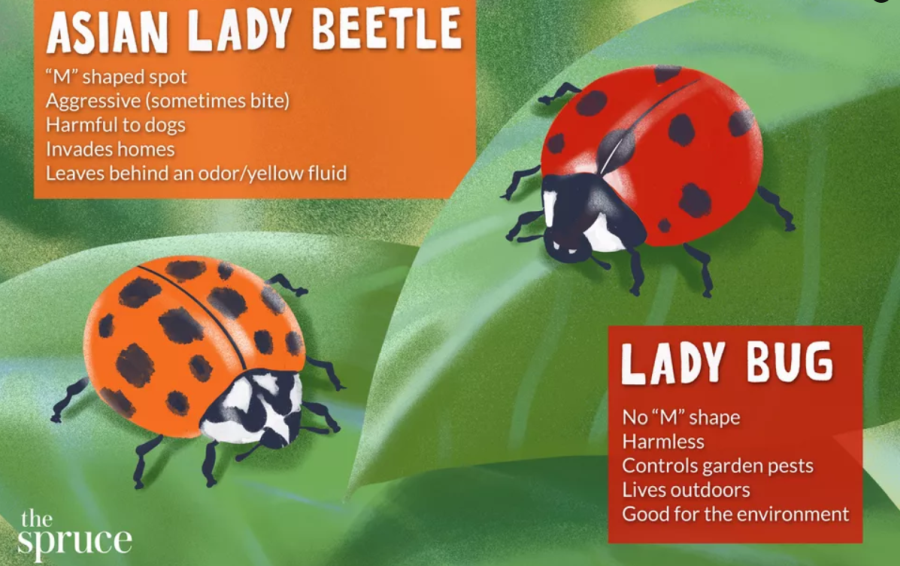Purchasing Beneficial Insects for Pest Control in the Garden.
Summer brings colorful blooms and lots of insect dilemmas. It seems everything can look great one day and be covered in bugs the next. Mainstream gardening education has taught us that bugs are bad (they’re not) and that they must be controlled immediately with chemicals (they don’t have to be!). With the rising popularity of chemical free, native gardening, many gardeners are opting for a more natural approach to pests by purchasing beneficial insects and releasing them into the garden. This is a great idea as long as the insects purchased are native to the area they are released in. After all, we don’t want to add to the pest problem by releasing the wrong kinds of bugs into the environment.
Here is some information about two commonly purchased insects: lady bugs and praying mantis.
Ladybugs:
If you have milkweed in your garden, you are probably very familiar with oleander aphids; you know, those little yellow bugs that crowd around stems and hang out on the underside of leaves. Some gardeners blast them off with water or wipe them off, but the problem with those methods is that monarch butterfly eggs can be lost in the process since they, too, are often found on the underside of milkweed leaves. Luckily, lady bugs love to eat aphids. They are a natural form of pest control and that is exactly why gardeners buy them. Here are two common lady bug species to avoid:
Avoid purchasing: Asian Lady Beetle (Harmonia axyridis) & the Convergent Ladybug (Hippodamia convergens)
Why: Harmonia axyridis is not native to the United States.. This beetle was introduced to the U.S from 1910 to 1980s for the purpose of aphid and scale control [1]. While this lady beetle is a great aphid predator, it can become a nuisance by overwintering in large groups on homes, in garages, and any other warm place including your pet’s mouth! Also, this lady beetle has displaced our native ladybugs because it is present in such large numbers and because it spreads disease and even eats our native ladybugs [2].
The Convergent Ladybug is native to the United States from New Jersey to Texas to California and is the most common ladybug available for purchase online and in stores. Since we are concerned with ecological conservation, we must do our best to introduce ladybugs that are native to NY.
Purchase instead:
Nine-spotted Ladybug (coccinella novemnotata)
This endangered ladybug is the state insect of NY [3]. This species can be purchased from The Lost Ladybug Rescue website: https://www.lostladybugrescue.com/
Pink Spotted Lady Beetle (Coleomegilla maculate)
This ladybug is native to the eastern half of the U.S from Canada down through New England and further down to Southern and Midwestern states [4]. It is available for purchase from Carolina Biological Supply Company (note we are not affiliated with this company).
Praying Mantis:
Each year people gleefully post in gardening groups about the praying mantis egg cases they found. They are excited because they know that the praying mantis is a great ally in the garden since it goes through each plant hunting for pests and is on guard throughout the summer and fall. However, most of the time people are finding egg cases of an invasive non-native praying mantis species.
Avoid purchasing: Chinese Mantis (Tenodera aridifolia or Tenodera Sinensis) egg cases
Tenodera aridifolia or Tenodera Sinensis egg cases are the ones usually sold online and in stores. These mantis species were accidentally introduced in 1896 [5] and have displaced our native mantis due to their increased size and voracious appetites. They can grow to up to 6” and can eat everything up to the size of a small bird! In fact, these mantises have been observed eating hummingbirds, small birds, mice, frogs, and snakes! [6]
Purchase or encourage:
Carolina Mantis (Stagmomantis Carolina)
There are very few places to purchase Carolina mantis egg cases, so make sure you are purchasing from a reputable seller. The Carolina mantis egg cases are long and narrow with a stripe running down the center. If you can’t purchase them, then simply work on eliminating the Chinese mantis egg cases you find and also eliminate pesticide/herbicide use in your garden. You may find that over time, the Carolina mantises will appear on their own since they are out there, there are just less of them.
Be on the lookout for:
European Mantis (Mantis Religiosa)
This is another non-native mantis present across the USA. This species was originally introduced accidentally and was later imported in the 1930s for garden insect control purposes [5]. This species is not usually sold but if you discover an egg case that looks similar to the Carolina mantis egg case but is much rounder and larger, then destroy it right away.
It is worth noting that it is difficult to identify a praying mantis without holding it close and examining it, so it’s best to leave adult mantises alone and destroy only the egg cases. The egg cases give a much better indication of which type of mantis you have.
For more examples of the Tenodera Sinensis egg cases and Stagmomantis Carolina mantis egg cases, visit University of Maryland Extension
[1] “Introduced Species Summary Project: Asian Lady Beetle.” Columbia, http://www.columbia.edu/itc/cerc/danoff-burg/invasion_bio/inv_spp_summ/Harmonia_axyridis.htm
[2] "Asian lady beetles use biological weapons against their European relatives." ScienceDaily, 16 May 2013, https://www.sciencedaily.com/releases/2013/05/130516142541.htm
[3] “Nine-spotted Lady Beetle.” Xerces Society, https://xerces.org/endangered-species/species-profiles/at-risk-beetles/nine-spotted-lady-beetle
[4] “Coleomegilla maculata.” College of Agriculture & Life Sciences. Cornell U. https://biocontrol.entomology.cornell.edu/predators/Coleomegilla.php
[5] “Praying Mantis- Indiscriminate Predator.” NJ Audobon, https://njaudubon.org/praying-mantis-indiscriminate-predator
[6] “Pray for the Prey of the Praying Mantis” Maryland Invasive Species Council, June 2019, http://mdinvasives.org/iotm/june-2019



